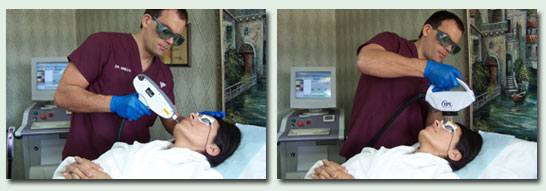
Laser / Photo Facial
Imagine reducing the effects of sun damage.
Photorejuvenation using IPL is a non-invasive treatment that treats skin damage without disruption of the skin's surface, hence, no "down time". Intense Pulsed Light (IPL) can simultaneously treat a wide range of facial concerns safely and effectively, such as broken capillaries, benign brown pigment, age spots (sun-induced freckles), mottled pigmentation and poikiloderma.
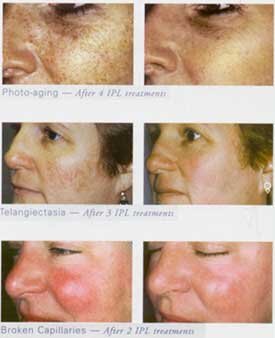
What is Intense Pulsed Light?
Intense Pulsed Light (IPL) technology is a treatment breakthrough that can correct a variety of benign skin conditions, such as facial skin imperfections, the signs of photo-aging, birthmarks, unwanted hair, unsightly small veins, and other blemishes. It offers a safe, non-invasive solution that can be tailored to your individual condition and skin type, providing superior cosmetic results and outstanding satisfaction, through a new process called photorejuvenation.
How is Photorejuvenation performed?
A cold gel is usually applied to the area to be treated, and you may be given dark glasses to protect your eyes from the bright light. The smooth glass surface of the IPL handpiece is gently applied to your skin and pulses of light are applied. You may feel a slight sting, like the snapping of a small rubber band. An anesthetic cream may be used, but is seldom required. Treatment is generally administered in a series of 4 to 6 sessions that provide excellent long-term results, minimal adverse effects and high satisfaction. Each treatment takes about twenty minutes.
Why are multiple treatments necessary?
Depending on the number of conditions you are treating, and the severity of the individual problem, a series of four to six treatment sessions may be recommended. You can return to work the same day and resume all your regular activities. By dividing the full program into several treatments, the procedure provides a gradual improvement with very low risk- and, it preserves the wonderful "no down time" feature that people appreciate so much.
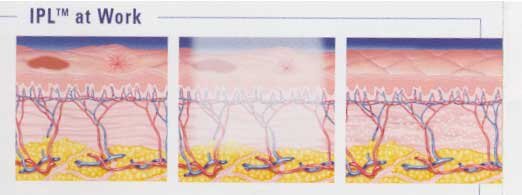
Red blemishes from broken blood vessels and brown spots of pigment from sun damge respond to Intense Pulsed Light. The light is changed to heat energy as it reaches to the level of the collagen beneath the skin surface.
How do other treatments compare to photorejuvenation?
While there are lasers that treat telangiectasia and broken capillaries, other lasers that treat benign brown pigments and others yet that are used for resurfacing facial skin, no technology provides the long-term improvement of complexion and texture of the IPL Skin Treatments using Photorejuvenation program-- all without the slightest interruption in your busy lifestyle.
What conditions can Photorejuvenation treat?
IMPERFECTIONS FROM SUN DAMAGE AND PHOTO AGING.
Facial imperfections or abnormalties can detract from your well being and appearance, no matter how healthy and young you feel. IPL technology helps create smoother-looking skin. After a series of treatments, you can see a significant reduction of unwanted pigmentation. The same treatment can be used effectively on the neck, chest, arms and hands.
BENIGN VASCULAR LESIONS: BROKEN VEINS AND CAPILLARIES
The face has an extensive network of veins and tiny blood vessels called capillaries. Over time, aging, trauma, sun exposure, and certain lifestyle factors cause a number of them to break appearing as red streaks or blotches on the face. IPL therapy can eliminate damaged veins and capillaries by removing virtually all traces of these unsighly blemishes.
REDNESS CAUSED BY BROKEN CAPILLARIES
Many people suffer from broken capillaries and diffuse erythema, that cause them social embarrassment. For both women and men, IPL can successfully treat dilated blood vessels without injuring the surrounding healthy skin.
Laser Hair Removal
Imagine not having to shave, tweeze wax or go through electrolysis again...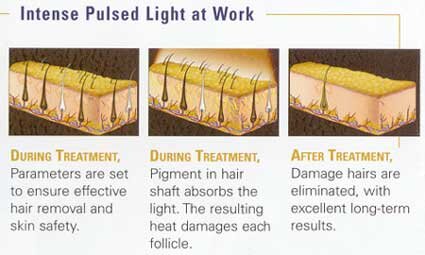
Intense Pulsed Light (IPL) technology offers a gentle, non-invasive, long lasting solution to unwanted hair on the face, back, legs, bikini line or any other body area. Based on technology used for nearly a decade in the treatment of port-wine stains and other birthmarks, IPL photoepilation has been performed safely for many years, effectively eliminating dozens of hairs with each pulse.
How does IPL remove hair?
Highly controlled flashes of light are selectively absorbed by hair filled follicles lying below the surface of the skin. The absorbed light heats the hair, which damages or destroys the regrowth potential of the follicle. All without damaging the surrounding tissue.
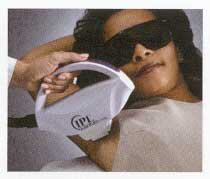 What happens during a treatment?
What happens during a treatment?
Your treatment begins by trimming away the hair above the skin. You may be asked to wear dark glasses to protect your eyes from the bright light. Next a cold gel (similar to ultrasound gel) may be spread over the treatment area. The IPL hand piece is then applied to your skin and pulses of light begin disabling your unwanted hair. When the gel is removed, much of the hair is wiped off with it. The remaining hair in the treated area falls out over the next week or two.
What does the treatment feel like?
Each pulse of light feels like a slight sting or pinch, similar to the snap of a rubber band. No local anesthesia is required and most people tolerate the treatment well.
Can all hair be treated?
IPL's unique design offers you customized treatment according to your hair color, texture and the location of the body hair. Any hair with at least some pigment in it (black, brown, red, and even blond) can be treated effectively.
Is IPL safe for all skin types?
IPL is the first photoepilation procedure proven to effectively treat unwanted hair on all types, including dark-skinned indivduals such as those of Black, Hispanic, and Asian descent.
Are there any possible side effects?
Side effects are rare. You may experience some slight reddening or local swelling at the treatment site, but this typically goes away within hours. On rare occasions, some blistering or brusing may occur, but typically resolves quickly. Also, the skin can become darker or lighter following treatment, but will generally return to normal within a few weeks. Limiting sun exposure before and after each treatment will minimize ther risk of complications.
Following the treatment, you can generally return to work and resume all regular activities immediately.
What kind of results should I expect?
IPL technology has been proven to create a permanent reduction in the number of regrowing hairs following each treatment in most skin types. The number of treatments required depends on several factors related to your specific kind of hair and skin. A customized treatment program will be designed for you along with an estimate of how many treatments you may nee in order to meet your expectations.
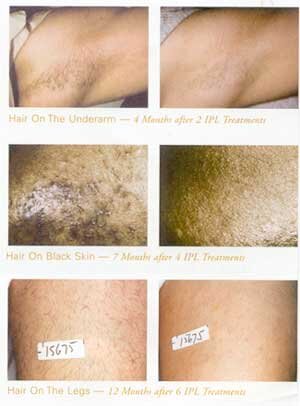
Leg Veins / Laser
Imagine beautiful legs free of unsightly veins.
Until now, treating varicose and spider veins was a lenghy and painful process with needles ro other invasive treatments. Now, using the new combined technologies of the VascuLight system, unsightly leg veins of all types can be treated-- simply, non-invasively, and successfully.
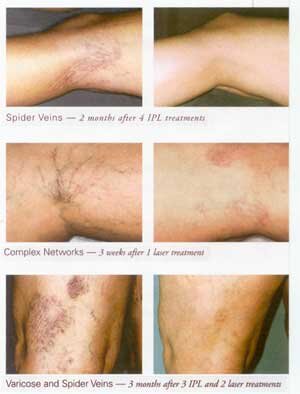 What types of leg veins can be treated?
What types of leg veins can be treated?
Varicose veins, usually deeper blue veins, need different treatment from discolored clusters (known as "spider veins") that are near the skin surface. For this reason the VascuLight system is equipped with two different light technologies. Your doctor may use either one or both, depending on your veins. Fortunately, there is now an effective non-invasive treatment for most cases.
What technology is used for deeper blue veins?
The laser component of the VascuLight system is used to treat larger, deeper veins ( i.e. reticular veins). These veins respond to the precise energy level and wavelength of light that is used. A small spot of laser light travels through the skin and is absorbed by the blood within the vein, on the basis of its color. Ther resulting heat coagulates or clots the blood and destroys the function of the vein. This process does not affect any of the surrounding tissue. Over time, the vein will be absorbed by the body and will disappear from sight.
Are surface veins and spider veins treated the same way?
These smaller, superficial structures require a different technology for sucessful treatment, not technically a laser at all. Smaller surface veins are treated using light energy. The light energy is absorbed by the blood, changed to heat, and the vein is destroyed. This Intense Pulsed Light (IPL) technology is exclusive to the VascuLight system. With both technologies, your doctor has the ability to use exactly what is needed for the best result.
How many treatments are needed?
Many leg veins need multiple treatments, often over a few months before the effect is complete. Even small vessels often require time to resolve. Sometimes a bit of "matting" or "staining" surrounds the treated vessel. By using both technologies in the VascuLight system, your doctor can treat the vein and this minor temporary discoloration and offer a complete, exellent outcome.
What is treatment like? Is it painful?
A pulse of laser or Intense Pulsed Light energy may feel like a pinch simiar to a snapped rubber band. Chilled gel on the skin and other techniques prevent discomfort. The entire procedure is brief and non-invasive-- no needles are used at any time.
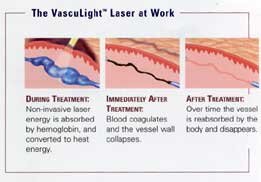
What preparations must I take?
You do not have to make changes to your normal activities, before or after treatment. Prior to and following any type of laser or IPL treatment, you must limit your exposure to the sun. Treatment should not be performed on tanned skin.
Is it right for you?
Your doctor will be happy to discuss this treatment with you and decide whether you are a candidate for this procedure. For more information on IPL solutions visit www.skinandhealth.com
Sclerotherapy
There have been many methods tried to remove unsightly "broken" or enlarged veins on the legs. Most do not work, and have been abandoned. The doctor uses a technique called sclerotherapy, which involves the following:
A tiny needle is threaded into the blood vessel and a small amount of a sclerosing agent is gently injected. This may sting for 20-30 seconds or cause a slight cramp. The injection "flushes" out the red blood cells temporarily, leading to an inflammatory reaction. This reaction causes "sclerosis", or the formation of fibrous tissue within the vessel, leading to the gradual disappearance of the vessel. This fading can take from a few weeks to a few months. Most areas will require between three to five treatments to fade.
